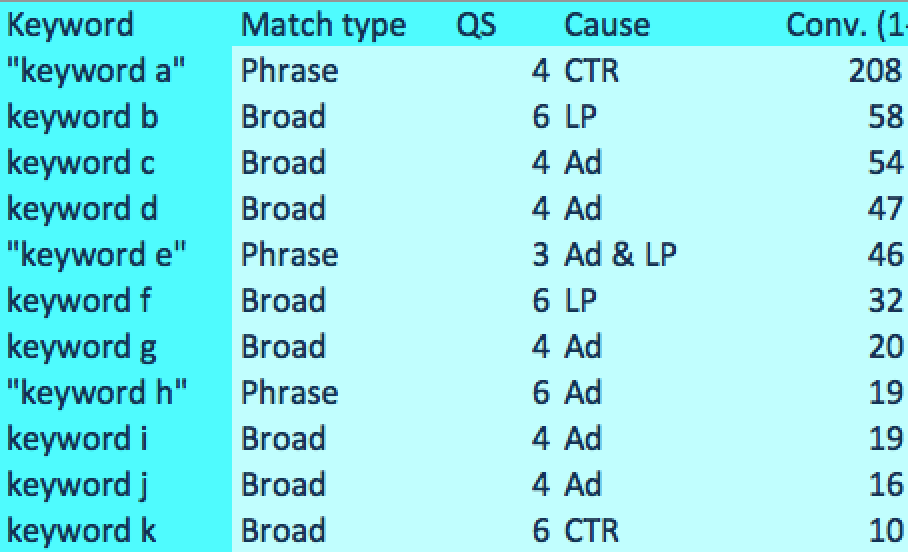Although I know I could while away the hours looking over hundreds of keywords with varying quality scores, there are times when you just need a quick and dirty approach to get the improvement ball rolling. As part of our series, I’ve provided a quick look at how I manage quality score when time is of the essence.
What’s all this “quick and dirty” talk?
- Quick: You filter out the words you want instead of sifting through pages of data or worse, pages of the interface.
- Dirty: Yes, this is a snapshot of quality score optimizing. Yes, it overlooks those keywords that just don’t do much.
- Save Time: You start to learn what the heavy weights in your account are and when it’s time to optimize, you’ve learned what keywords do the driving in your different campaigns.
Save Money: When you improve your Quality Score, Google and Bing reward you! Be it through an average position boost, or a lower CPC getting you the same (or better) impressions. Improving your quality score has a wonderful trickle down effect!
Disclaimer: You may recall a blog post from earlier this year, providing some fantastic scripts for analyzing your accounts. I strongly, nay, vehemently suggest using the Quality Score tracker for at least some aspect of your PPC management. Until Google starts letting us see our QS from days gone by, this is the best we got (and it’s pretty good)!
Q&D 101 for AdWords:
- Download a keyword report (including current quality score) for the last 90 days. Filter for keywords with QS less or equal to 6 and filter out anything that hasn’t converted at least once. Once you’ve got this list, pull it down to the top spending keywords. I typically try to limit a single analysis to 10-15 words, with 20 being the absolute maximum.
(Dirty: yes, there are more keywords than this in your account. And you may want to include them or include some that have fewer conversions, but ya just really like them. Go for it! This demo shows how I target my optimizations to the top performers, hence the broad strokes focused on major performance).
- Download your report, but keep your interface open.
- Take a look at your keywords. At your bids. At your average position. Then slide on over to your status. This is where the real magic begins.
As you look over your heavy-lifting keywords, make note of what is troubling them. Is it the CTR? Ad relevance? Landing page relevance?
These are my top-converting keywords below. As I collect the factors related to the low QS, I drop them into my spreadsheet as CTR or Ad Relevance or LP Relevance.
As I uncover the source of your low (or simply unsatisfactory), I begin to remedy the issue using some of the tactics we’ve included in our Ultimate Guide To Quality Score.
I generally follow a pretty standard series of quick solutions and fill in my table as such:
An example of low CTR could be because I’m simply gathering lots of impressions, but not enough people are clicking regularly. When I hover over the Status bubble, I see a couple things.
First, that I’m losing impressions to an exact match version of the same keyword. Understandable, but what can I do? I can lower my exact bid. I can raise my phrase match bid. Or I can simply accept that they will share similar traffic and work on what will improve CTR when it does impress.
How might I do this? Adding extensions is a great way to give users more opportunities to click. Be it through a call extension, an offer extension, or oh-so-many sitelinks options, I know that improving the experience my user has when they see my ad can serve to improve my CTR and thus my QS.
Another example might be if the landing page isn’t terribly relevant and neither is my ad.
What we don’t see in this snapshot is that my keyword is actually a competitor’s term! Bidding on a competitor’s term is tricky. I have several clients who pull in a lot of high quality traffic based on a very comparable competitor’s trademarked name. How can I possibly improve my QS? Although I know that my ad copy can’t include a trademarked term, I can include relevant language on my landing page. I can give user testimonials who reference my competitor and how my product/service is better. Landing page relevance, in yo’ face!
After assessing the keywords with the greatest lead volume and implementing some changes aimed directly at QS, I need to be able to watch it grow and flourish.
Then using the handy-dandy Quality Score Tracker script, I can actually see how my QS changes day after day, week over week!
This method allows me to consider the heavy lifters in my account. As they receive a TON of my conversion traffic, I want to keep my clicks affordable and in their prime position. Quality score is absolutely the gateway to these things and my quick & dirty method keeps me on top of the ways I can keep them in good health!
There are certainly other approaches to saving time on QS optimizations, let’s here ‘em, heroes! Let us know what other time-savers you’ve got!





